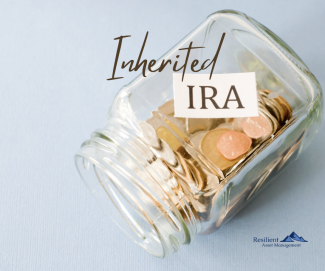
What to do with an Inherited IRA
Retirement Plans of any stripe can be confusing – both to professionals and amateurs alike. At the end of 2022, the SECURE (Setting Every Community Up for Retirement Enhancement) Act changes to the rules governing IRAs (Individual Retirement Accounts) did nothing to simplify one’s understanding. In fact, one could argue, the situation is a fair bit more complex. This complexity warrants some explanation and some suggestions for the new realities one faces with Inherited IRA money. The new rules are presently in-force, so if you are fortunate enough to have inherited an IRA, you would be well-advised to be very familiar with the rules governing Inherited IRAs…they are a tangled web indeed!
The Inherited IRA New Rules
Spouses
This part is “fairly” simple. A good number of couples are “relatively” close in age. For those couples, a Surviving Spouse has an option no other beneficiary has: to rollover the deceased’s IRA assets into his/her own IRA. This probably makes a lot of sense for the majority of Survivors.
If there is a large age gap in the marriage, other options might make sense. For example, if the Surviving Spouse is not yet 59 ½ and is in need of the funds, he/she may want to take the funds in a Beneficiary IRA. Beneficiary IRAs are unique in that there are no early withdrawal penalties on distributions before age 59 ½ as there would be in most cases with a Traditional IRA.
Additionally, a Surviving Spouse may want to rollover the funds to a new Traditional IRA and convert the funds to a Roth IRA.
Because most – not all – Surviving Spouses will likely rollover funds into his/her own IRA, I will not spend any more time discussing spousal options.
Non-Spouses
Before getting into the meat of options, let’s quickly address exceptions:
1) Minors: Only stretch distributions determined by the IRS Single Life Expectancy Table are required until age 18, upon which the 10-Year Clock (Described Below) starts.
2) An Inheritor less than 10 years younger than the original IRA owner. These individuals are permitted stretch distributions determined by the IRS Single Life Expectancy Table
3) Someone disabled or chronically ill (as defined under the applicable sections of the Internal Revenue Code)
These exceptional cases will likely be quite rare. If you fall into one of these categories, please seek the assistance of your Tax Advisor and Financial Planner for guidance.
For the vast majority of Non-Spouse Inheritors, the following rules will apply:
Generally Speaking, the Inherited IRA Account must be completely depleted within 10 years.
a) If the Original IRA Owner had already begun taking RMDs (Required Minimum Distributions), an RMD for the current year is required using the Original IRA Owner’s RMD amount. Subsequent RMDs can be calculated using the Beneficiary’s Age in the IRS Single Life Expectancy Table.
b) If the Original IRA Owner had not begun RMDs, then the Beneficiary can wait until the following year to begin taking RMDs with the caveat that the entire account must be $0 by December 31 in the year after the 10th Anniversary of the Original IRA Owner’s Death.
Let’s look at an example:
Original IRA Owner: Bob is age 74 and had a Traditional IRA Balance of $100,000 on December 31, 2022. Bob passed away on January 31, 2023 without taking his 2023 RMD. Bob left his entire IRA Balance to his daughter Alice.
Beneficiary: Alice is 50 Years old and is neither chronically ill nor disabled.
Alice’s To-Do List:
1) Work with the Executor of Bob’s Estate to identify her father’s IRA Account
2) Work with her Father’s Custodian to establish an Inherited IRA…this process is fairly standard, though a Death Certificate is a requirement to open the account.
3) Distribute what would have been her Father’s RMD for 2023:
(i) 2022 End-of-Year Balance: $100,000
(ii) Her Father’s RMD Divisor using the IRS Table: 15.6
(iii) Calculate the RMD: $100,000 / 15.6 = $6,410.26
(iv) Distribute $6,410.26. This amount is fully taxable as regular income to Alice
(v) In 2024, Alice’s 10-Year Clock begins and she is required to take RMDs as follows:
(a) Use the End-of-Year 2023 Balance, we will assume $100,000 for simplicity…this assumes some investment gains after the 2023 RMD
(b) Use Alice’s Single Life Expectancy from the IRS Table (51 Years old…she was 50 in 2023) – 35.3
(c) Calculate the RMD: $100,000 / 35.3 = $2,832.86
(d) This is the MINIMUM distribution – she can distribute up to the total value of the account
(e) Repeat this process every year incrementing the RMD divisor by 1 while seeking to make the account balance $0 by December 31, 2034
Tax Strategies for Drawing Down Inherited IRAs
1) Straight Line Method
This method looks to equally divide realized income amongst the allowable 10-Year period. Obviously, this is not completely achievable as the account valuations will change due to investment fluctuations and the Alice’s increasing age will decrement the divisor. In general, this method will result in “mostly equal” withdrawals.
This strategy is best-suited for those with “regular” income – by “regular” we are speaking of Military or Other Government Personnel, or those whose income varies very little from year-to-year.
By employing this strategy, the year-to-year income increase will be somewhat even, thus the tax implications will be similar over the 10-Year depletion period.
2) Maximize Employer Retirement Account Contribution Method
This method seeks to offset the Inherited IRA distribution with contributions to one’s employer-provided retirement plan – a 401(k), 403(b), or the Thrift Savings Plan for example.
This strategy is best-suited to those who for one reason or another have not been contributing to his/her employer-provided retirement plan. If, for example, the Inherited IRA RMD is $15,000, one could make $15,000 in Thrift Savings Plan (or 401(k)) contributions and be in almost exactly the same Income Tax situation as before he/she inherited the IRA.
3) Tax Minimization Method
This method looks to weight Inherited IRA distributions to those years when the Beneficiary’s Income is “low”.
This strategy is best suited to those whose income is highly variable. For example, say Alice (from the example above) is a Real Estate Agent. She probably had a very good year in 2021, perhaps a somewhat less great year in 2022, and 2023 might be even worse. Whenever her income is “low”, she may want to realize significantly more than the Required Minimum Distribution (RMD) as this distribution might represent most of her income, and thus, be taxed at a lower rate as she can take advantage of the lower tax brackets.
The method will also suit those who are considering a sabbatical or who may want to take extended time away from work for a family matter, such as increasing its size! Bottom Line, if you own an Inherited IRA and your income is low, you may want to consider beefing up your distributions.
4) Inherited Roth IRA Method
Roth IRAs are the mother’s milk of the investment world. No taxes on trades and no taxes on withdrawals – one could not devise a more optimal investment beast. With an Inherited Roth IRA, sadly, the funds must come out within 10 years just as described above. Happily, all withdrawals will be free of income tax.
For these types of Inherited IRAs, one may want to simply take the minimum distributions until the 10th year and the distribute the remainder. Alternatively, there may be opportunities to distribute the Inherited IRA funds so that other retirement accounts may be topped off…Back Door Roth IRA and Mega Back Door Roth IRA contributions are examples. Because there are no tax consequences within the Inherited Roth IRA and the distributions are tax-free, the playbook is quite vast for the Beneficiaries of Roth IRAs.
Analyze Your Options and Select Carefully
IRAs are complicated for Owners. The complexity does not diminish for those inheriting these assets. So, if you find yourself having to navigate the complicated maze of the rules governing Inherited IRA, please seek the appropriate guidance necessary to both avoid unnecessary IRS penalties and accomplish your financial goals. You do not want to squander your loved one’s life savings on needless IRS penalties for not following their persnickety rules.
Need a little more help and guidance navigating an Inherited IRA or other financial topic? Schedule a free, no-obligation consultation with us and let's have a conversation to see if we can help.




